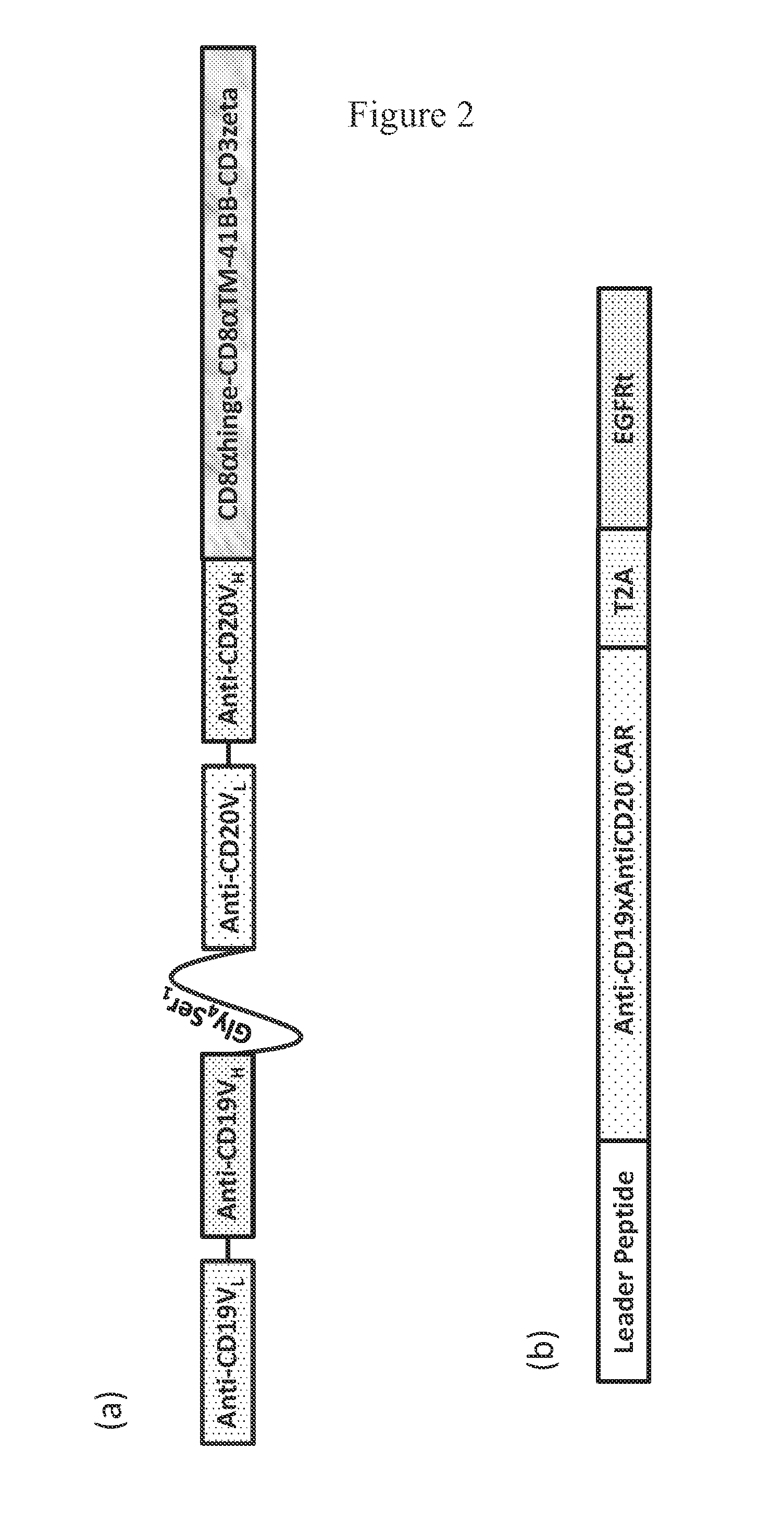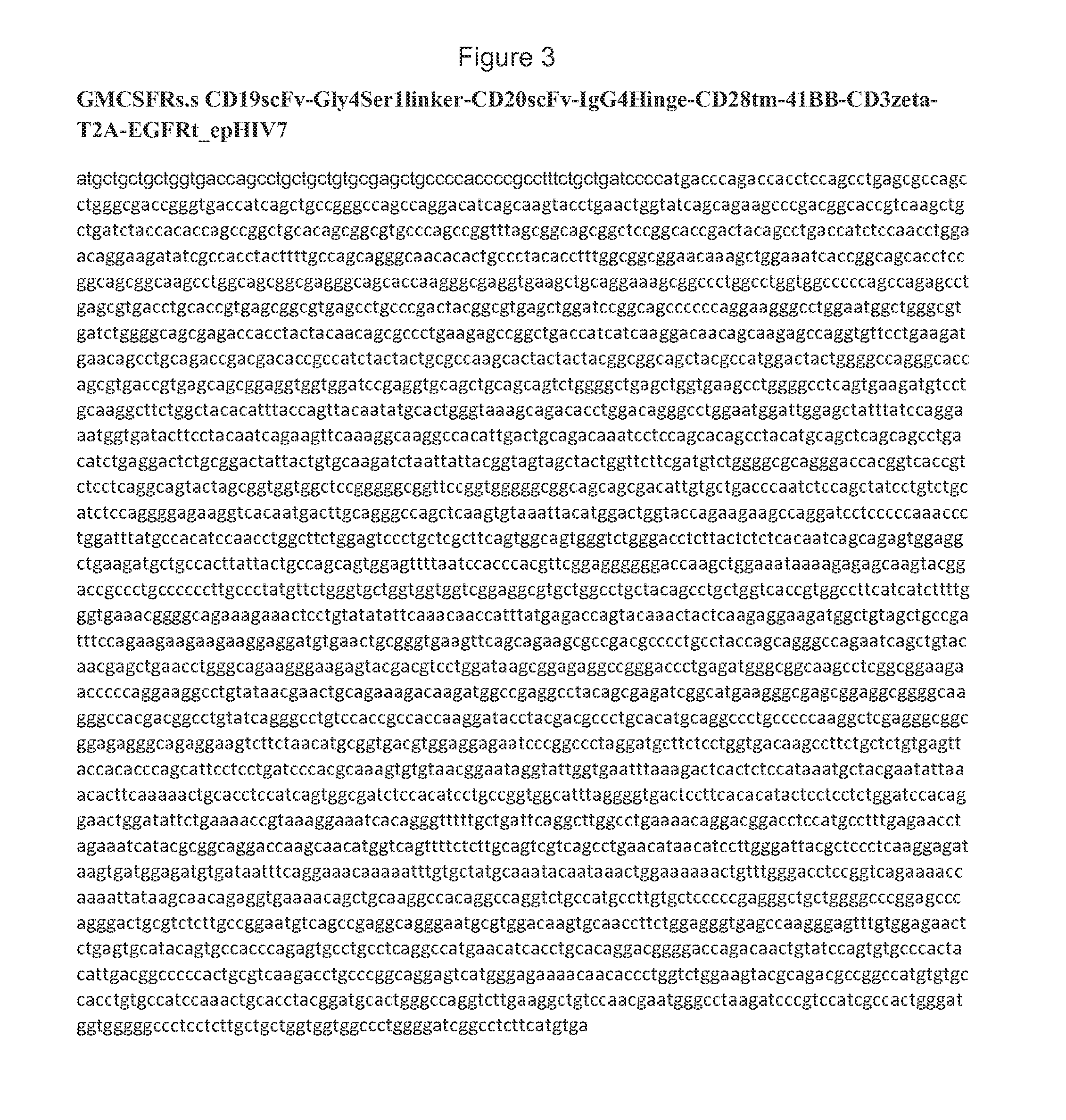Bispecific chimeric antigen receptors and therapeutic uses thereof
a technology of chimeric antigen receptors and bispecific chimeric antigens, which is applied in the direction of immunoglobulins, peptides, drugs, etc., can solve the problems of unstable cancer cells and cells that no longer possess the target antigen
- Summary
- Abstract
- Description
- Claims
- Application Information
AI Technical Summary
Benefits of technology
Problems solved by technology
Method used
Image
Examples
example 1
[0132]FIG. 1 is a schematic representation of the bispecific chimeric antigen receptor of the invention. In an exemplary embodiment of the invention, FIG. 2 depicts the components of bispecific anti-CD19xanti-CD20 bispecific CAR. FIG. 2 also depicts a schematic of the complete cDNA packaged into epHIV-7 lentivirus vector transfer plasmid. FIGS. 3 and 4 show the nucleic and amino acid sequences of an exemplary bispecific CAR, namely GMCSFss-CD19scFv-Gly4Ser1linker-CD20scFv-IgG4Hinge-CD28tm-41BBzeta-T2A-EGFRt_epHIV7.
example 2
[0133]FIG. 5 is a schematic showing the vector construct of an exemplary CAR of the invention, namely, the CD19scFv-CD20scFv-IgG4-CD28tm-CD28costim-CD3zeta transgene construct. The CD 19scFv-CD20scFv-IgG4-CD28tmCD28costim-CD3zeta transgene was assembled using the one-step isothermal DNA assembly method previously described by Gibson et. al. (Enzymatic assembly of DNA molecules upto several hindred kilobases. Nature Methods. 2009;6:343-345). The VL and VH domains of the CD19 scFv construct was sequenced from a CD19CAR-CD28-Zeta transgene previously described. Schmitz N, Dreger P, Glass B, Sureda A. Allogeneic transplantation in lymphoma: current status. Haematologica. 2007; 92(11):1533-1548) through polymerase chain reaction (PCR). The VH and VL domains of the CD20 scFv were assembled by spliced-overlap polymerase chain reaction using a CD20R-CD28-Zeta transgene previously described (Michael Jensen et al., CD20 is a molecular target for scFvFc:zeta receptor redirected T-cells: implic...
example 3
[0134]HEK 293T-cells were transfected with anti-CD19xCD20CAR-T2A-EGFRt epHIV-7 transfer plasmid or with anti-CD20xCD19CAR-T2A-EGFRt epHIV-7 transfer plasmid. Transfected cells were stained with biotinylated anti-Fc antibodies and streptavidin PE (SA-PE) and then were subjected to flow cytometric analysis for detection of expression of the above two CARs. Both the anti-CD19xCD20 CAR and the anti-CD20xCD19 CAR were expressed on transfected HEK 293T cells.
[0135]The epHIV-7 transfer plasmid co-expressed EGFRt with the above two bispecific CARs. EGFRt co-expression was detected on the same transfected cells using a combination of biotinlylated anti-EGFR antibodies / SA-PE staining and flow cytometric analysis.
PUM
| Property | Measurement | Unit |
|---|---|---|
| Current | aaaaa | aaaaa |
| Hydrophobicity | aaaaa | aaaaa |
Abstract
Description
Claims
Application Information
 Login to View More
Login to View More - R&D
- Intellectual Property
- Life Sciences
- Materials
- Tech Scout
- Unparalleled Data Quality
- Higher Quality Content
- 60% Fewer Hallucinations
Browse by: Latest US Patents, China's latest patents, Technical Efficacy Thesaurus, Application Domain, Technology Topic, Popular Technical Reports.
© 2025 PatSnap. All rights reserved.Legal|Privacy policy|Modern Slavery Act Transparency Statement|Sitemap|About US| Contact US: help@patsnap.com



